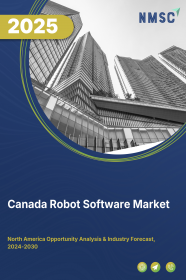
Canada Robot Software Market by Software Type (Recognition Software, Simulation Software, Predictive Maintenance Software, Communication Management Software, and Data Management and Analysis Software), by Robot Type (Service Robots and Industrial Robots), by Deployment Mode (On-premise and On-demand), by Organization Size (Large Enterprises and Small and Medium-sized Enterprises (SMEs) – Opportunity Analysis and Industry Forecast, 2024–2030
Industry: ICT & Media | Publish Date: 14-Feb-2025 | No of Pages: 126 | No. of Tables: 92 | No. of Figures: 57 | Format: PDF | Report Code : IC2377
Canada Robot Software Market Overview
The Canada Robot Software Market size was valued at USD 296.0 million in 2023, and is expected to reach USD 1260.0 million by 2030, with a CAGR of 22.0% from 2024 to 2030. The realm of robot software encompasses an array of programs and algorithms tailored to regulate the actions of robots or robotic systems. These systems serve a multitude of industries, including logistics, manufacturing, entertainment, healthcare, and more. At its core, robot software manages and coordinates robot movements and behaviors, ensuring precise task execution by issuing detailed commands to robotic components.
Additionally, it interprets data from a variety of sensors embedded within robots, providing vital environmental feedback for perception and comprehension. Through AI and ML algorithms, robot software enables intelligent decision-making, allowing robots to adapt autonomously to changing circumstances and collaborate with other robots for enhanced efficiency in industrial environments.
Increasing Adoption of Industrial Robots Propels the Growth of the Canada Robot Software Market
The escalating adoption of industrial robots serves as a significant catalyst propelling the growth of the Canada robot software market. As industries across various sectors increasingly embrace automation in their operations, there is a parallel increase in demand for efficient robot software solutions. Industrial robots are being deployed across a wide spectrum of tasks, from manufacturing and assembly to logistics and warehousing. To fully exploit the capabilities of these robots and seamlessly integrate them into existing workflows, sophisticated software solutions are indispensable. These software platforms facilitate programming, control, optimization, and coordination of robotic systems, thereby enhancing their performance and productivity. Consequently, the rising adoption of industrial robots fuels the demand for advanced robot software, driving growth of the Canada robot software market trends.
Increasing Investments in Research and Development (R&D) Drive the Canada Robot Software Market Growth
Increasing investments in research and development (R&D) are essential drivers behind the growth of the Canada robot software market demand. With organizations and governments allocating more resources to R&D initiatives, the focus on advancing robotics and automation technologies, including robot software, intensifies. These investments spark innovation, resulting in the development of increasingly sophisticated and capable robot software solutions. R&D efforts significantly contribute to enhancing functionalities such as AI integration, machine learning algorithms, and advanced control systems, enabling robots to perform complex tasks with greater efficiency and autonomy.
Furthermore, R&D investments drive the exploration of new applications and use cases for robot software across diverse industries, expanding the market's potential. By promoting technological advancements and addressing emerging challenges, heightened R&D investments continue to stimulate market growth and drive the evolution of the robot software market.
Cybersecurity and Data Protection Concerns Associated with Robot Software Restrain the Market Growth
Cybersecurity and data protection concerns associated with robot software represent significant hurdles to the market's growth in the country. As robots become increasingly interconnected within digital ecosystems, they are exposed to various cyber threats, including unauthorized access, data breaches, and malware attacks. Insufficient cybersecurity measures within robot software can compromise sensitive data, intellectual property, and operational integrity, potentially resulting in financial losses and reputational damage for organizations.
Moreover, with the proliferation of IoT-enabled robots and the accumulation of vast amounts of data, there is an elevated risk of data privacy violations and regulatory non-compliance. Consequently, organizations are cautious about adopting robot software solutions lacking robust cybersecurity features and data protection mechanisms, which restrains market growth. Addressing these concerns through enhanced cybersecurity measures, encryption protocols, and compliance frameworks is essential to build trust and drive wider adoption of robot software across diverse industries.
Development of Digital Twins and Simulation Software Creates New Opportunities in the Canada Robot Software Market
The development of digital twins and simulation software introduces new opportunities in the market by providing advanced tools for modeling, testing, and optimizing robotic systems in the country. Digital twins create virtual replicas of physical robots and their environments, enabling real-time monitoring, analysis, and predictive maintenance. Simulation software allows users to simulate various scenarios and environments, validating robot software algorithms and enhancing performance before deployment. These technologies offer significant benefits, including reduced development time and costs, improved scalability, and enhanced risk management.
Additionally, digital twins and simulation software support collaborative development and training, enabling stakeholders to iterate and refine robot software solutions more effectively. By furnishing powerful tools for design, testing, and optimization, the development of digital twins and simulation software drives innovation and accelerates the adoption of robot software across various industries.
Competitive Landscape
Several key players operating in the Canada robot software industry include IBM, NVIDIA, ABB Ltd., FANUC, Teradyne, Inc., H2O.ai, Brain Corp, CloudMinds, Clearpath Robotics, and Neurala, Inc. These market players are adopting strategies to maintain their dominance in the market.
Canada Robot Software Market Key Segments
By Software Type
-
Recognition Software
-
Simulation Software
-
Predictive Maintenance Software
-
Communication Management Software
-
Data Management and Analysis Software
By Robot Type
-
Service Robots
-
Ground
-
Aerial
-
Underwater
-
-
Industrial Robots
-
Traditional Industrial Robots
-
Articulated Robots
-
SCARA Robots
-
Parallel Robots
-
Cartesian Robots
-
Other Robots
-
-
Collaborative Industrial Robots
-
By Deployment Mode
-
On-premise
-
On-demand
By Organization Size
-
Large Enterprises
-
Small and Medium-sized Enterprises (SMEs)
By Industry Vertical
-
Banking, Financial Services, and Insurance (BFSI)
-
Automotive
-
Retail and eCommerce
-
Aerospace & Defense
-
Healthcare and Life Sciences
-
Transportation and Logistics
-
Manufacturing
-
Telecommunications and IT
-
Academia and Research
-
Media & Entertainment
-
Others
REPORT SCOPE AND SEGMENTATION:
|
Parameters |
Details |
|
Market Size in 2023 |
USD 296.0 Million |
|
Revenue Forecast in 2030 |
USD 1260.0 Million |
|
Growth Rate |
CAGR of 22.0% from 2024 to 2030 |
|
Analysis Period |
2023–2030 |
|
Base Year Considered |
2023 |
|
Forecast Period |
2024–2030 |
|
Market Size Estimation |
Million (USD) |
|
Growth Factors |
|
|
Companies Profiled |
10 |
|
Market Share |
Available for 10 companies |
|
Customization Scope |
Free customization (equivalent up to 80 working hours of analysts) after purchase. Addition or alteration to country, regional, and segment scope. |
|
Pricing and Purchase Options |
Avail customized purchase options to meet your exact research needs. |
KEY PLAYERS
-
IBM
-
NVIDIA
-
ABB Ltd.
-
FANUC
-
Teradyne, Inc.
-
H2O.ai
-
Brain Corp
-
CloudMinds
-
Clearpath Robotics
-
Neurala, Inc

















 Speak to Our Analyst
Speak to Our Analyst





















